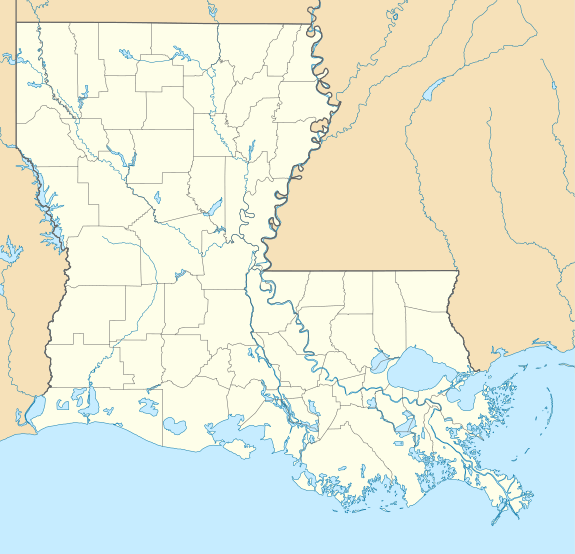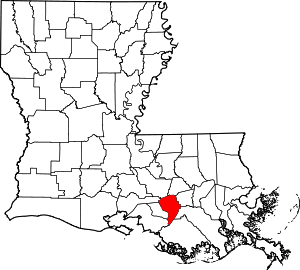Labadieville, Louisiana
Labadieville is a census-designated place (CDP) in Assumption Parish, Louisiana, United States. The population was 1,854 at the 2010 census.[1] It is part of the Pierre Part Micropolitan Statistical Area.
Labadieville, Louisiana | |
|---|---|
 Labadieville, Louisiana Location of Labadieville in Louisiana | |
| Coordinates: 29°49′57″N 90°57′17″W | |
| Country | United States |
| State | Louisiana |
| Parish | Assumption |
| Area | |
| • Total | 3.9 sq mi (10.1 km2) |
| Elevation | 16 ft (5 m) |
| Population (2010) | |
| • Total | 1,854 |
| • Density | 480/sq mi (180/km2) |
| Time zone | UTC-6 (CST) |
| • Summer (DST) | UTC-5 (CDT) |
| Postal code | 70372 |
| Area code(s) | 985 |
History
Labadieville, originally called "Brulee Labadie", takes its name from a French pioneer and resident, Jean Louis L'Abadie. In 1721, there were some fifty warriors of the Chitimacha tribe. During the two decades after 1750, the area around Labadieville was taken up by French and Spanish, joined by Acadians, Isleños and a sprinkling of Germans from the Cote des Allemands or German Coast to the east on the Mississippi River.
In 1843, a mission was established. St. Philomena Catholic Church dates from 1848 as an organized parish, and the first mass was said in the home of Widow Zacharie Boudreaux. The first building was occupied in 1847.
During the Civil War, Labadieville was the scene of the Battle of Georgia Landing, Oct. 27, 1862, between Union forces under Gen. Weitzel and a body of Confederate troops under Brig. Gen. Alfred Mouton. Major General Benjamin F. Butler, commanding Union forces in the Department of the Gulf, launched an expedition into the Bayou Lafourche region to eliminate the Rebel threat from that area, to make sure that sugar and cotton products from there would come into Union hands and, in the future, to use it as a base for other military operations. Gen. Weitzel, Butler's protégé, with five regiments from the Reserve Brigade, Department of the Gulf (numbering about 4,000 men), left Carrollton, 7 miles (11 km) above New Orleans, on Oct. 24, and went up the Mississippi River in transports conveyed by gunboats. Reaching Donaldsonville the next day, the troops were disembarked. On the 26th, they marched down the Bayou Lafourche 15 miles (24 km) to Napoleonville, but were unable to find the Confederate force known to be in that region. On the 27th Gen. Weitzel continued his march to Labadieville, on the east bank of the bayou, where he found the enemy in considerable force entrenched on both sides of the bayou, with six pieces of artillery in battery. Confederate forces included the 18th Louisiana Infantry Regiment, Crescent Regiment, Ralston's Battery, Detachment of Cavalry, 33rd Louisiana Infantry Regiment, Terre Bonne Regiment of the Louisiana Militia, Semmes's Battery and 2nd Louisiana Cavalry Regiment (approx. 1,392 men).
Gen. Weitzel's troops began skirmishing with Confederate positions on the east bank at about 11:00 a.m. Lacking the artillery support of the troops entrenched on the west bank of the bayou, Confederate troops in these positions retired quickly. By means of a floating bridge Gen. Weitzel began crossing his men to the west bank to attack the Rebel troops there. For some time, these Confederate troops fought resolutely and brought the Union assault to a standstill. However, a lack of artillery ammunition compelled the Confederate forces to abandon these positions as well. Confederate forces retreated up the bayou to Labadieville.
Union losses were 18 killed and 68 wounded. Confederate losses were estimated at 229. Additionally, 206 Confederates were taken prisoner. On the 28th Weitzel entered and occupied Thibodaux, a few miles below Labadieville, and on the 29th communication was opened with New Orleans by means of the New Orleans, Opelousas and Great Western Railroad. The result of the expedition was to open the whole region of the Bayou Lafourche to Union occupation.
In 1905, a canal, called the Cancienne, leading east from Lake Verret to Bayou Lafourche near Napoleonville, was constructed.[2]
Geography
Labadieville is located at 29°49′57″N 90°57′17″W (29.832537, -90.954692).[3]
According to the United States Census Bureau, the CDP has a total area of 3.9 square miles (10.1 km2), all land.[1]
Demographics
As of the census[4] of 2000, there were 1,811 people, 666 households, and 514 families residing in the CDP. The population density was 466.5 people per square mile (180.2/km2). There were 709 housing units at an average density of 182.6 per square mile (70.6/km2). The racial makeup of the CDP was 81.12% White, 17.50% African American, 0.28% Native American, 0.17% Asian, 0.17% from other races, and 0.77% from two or more races. Hispanic or Latino of any race were 1.10% of the population.
There were 666 households out of which 36.9% had children under the age of 18 living with them, 61.7% were married couples living together, 13.1% had a female householder with no husband present, and 22.7% were non-families. 18.8% of all households were made up of individuals and 9.0% had someone living alone who was 65 years of age or older. The average household size was 2.72 and the average family size was 3.12.
In the CDP, the population was spread out with 26.5% under the age of 18, 10.3% from 18 to 24, 29.3% from 25 to 44, 22.6% from 45 to 64, and 11.2% who were 65 years of age or older. The median age was 35 years. For every 100 females, there were 92.9 males. For every 100 females age 18 and over, there were 89.9 males.
The median income for a household in the CDP was $35,417, and the median income for a family was $43,438. Males had a median income of $34,904 versus $22,063 for females. The per capita income for the CDP was $14,865. About 12.4% of families and 17.5% of the population were below the poverty line, including 26.4% of those under age 18 and 24.9% of those age 65 or over.
Notable person
Self-taught folk artist Mary Anne de Boisblanc was born in Labadieville in 1925.[5]
References
- "Geographic Identifiers: 2010 Demographic Profile Data (G001): Labadieville CDP, Louisiana". U.S. Census Bureau, American Factfinder. Archived from the original on February 12, 2020. Retrieved May 16, 2013.
- www.rootsweb.com "History of Assumption Parish" Archived 2005-02-13 at the Wayback Machine
- "US Gazetteer files: 2010, 2000, and 1990". United States Census Bureau. 2011-02-12. Retrieved 2011-04-23.
- "U.S. Census website". United States Census Bureau. Retrieved 2008-01-31.
- "Mary Anne de Boisblanc Collection 12-002". Newcomb Archives. Newcomb Center for Research on Women. Retrieved 14 March 2016.
